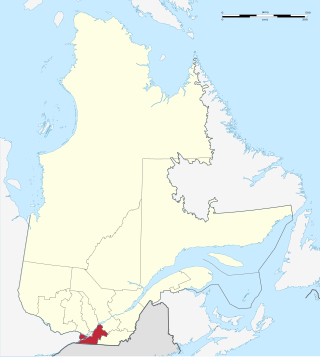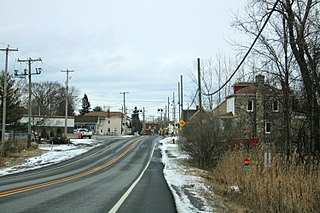
Longueuil is a city in the province of Quebec, Canada. It is the seat of the Montérégie administrative region and the central city of the urban agglomeration of Longueuil. It sits on the south shore of the Saint Lawrence River directly across from Montreal. The population as of the Canada 2021 Census totalled 254,483, making it Montreal's second largest suburb, the fifth most populous city in Quebec and twentieth largest in Canada.

Saint-Jean-sur-Richelieu is a city in eastern Montérégie in the Canadian province of Quebec, about 40 kilometres (25 mi) southeast of Montreal, located roughly halfway between Montreal and the Canada–United States border with the state of Vermont. It is situated on both the west and east banks of the Richelieu River at the northernmost navigable point of Lake Champlain. As of December 2019, the population of Saint-Jean-sur-Richelieu was 98,036.

La Vallée-du-Richelieu(The Valley of the Richelieu) is a regional county municipality in the Montérégie region in southwestern Quebec, Canada. Its seat is McMasterville.

Brossard is a municipality in the Montérégie region of Quebec, Canada and is part of the Greater Montreal area. According to the 2021 census, Brossard's population was 91,525. It shares powers with the urban agglomeration of Longueuil and was a borough of the municipality of Longueuil from 2002 to 2006.

Saint-Constant is a city in southwestern Quebec, Canada. It is located on the south shore of Montreal in the Roussillon Regional County Municipality of the Montérégie region. The population as of the Canada 2016 Census was 27,359.

Sainte-Catherine is an off-island suburb of Montreal, in southwestern Quebec, Canada, on the St. Lawrence River in the Regional County Municipality of Roussillon. The population as of the Canada 2011 Census was 16,762.

Montérégie is an administrative region in the southwest part of Quebec. It includes the cities of Boucherville, Brossard, Châteauguay, Longueuil, Saint-Hyacinthe, Saint-Jean-sur-Richelieu, Salaberry-de-Valleyfield and Vaudreuil-Dorion.
La Prairie is a federal electoral district in Quebec, Canada, that was represented in the House of Commons of Canada from 1867 to 1896, 1968 to 1997 and again since 2015.

Candiac is a suburb of Montreal, in the Canadian province of Quebec; it is located on the South Shore of the Saint Lawrence River opposite Montreal near La Prairie. The population as of the Canada 2021 Census was 22,997.

Beauharnois—Salaberry is a former federal electoral district in Quebec, Canada, that was represented in the House of Commons of Canada from 1949 to 2015.

Chambly—Borduas was a federal electoral district in the province of Quebec, Canada, that was represented in the House of Commons of Canada from 1867 to 1935, and from 1968 to 2015. Created by the British North America Act of 1867, its name was changed in 1893 to "Chambly—Verchères". In 1933, it was amalgamated into the Chambly—Rouville and Richelieu—Verchères electoral districts. The district was re-created in 1966 from Chambly—Rouville, Châteauguay—Huntingdon—Laprairie, and Richelieu—Verchères. Its name was changed in 2003 to "Chambly—Borduas". In 2015, most of the district became part of Beloeil—Chambly, while small parts of it joined Montarville and Pierre-Boucher—Les Patriotes—Verchères.

Saint-Jean is a federal electoral district in Quebec, Canada, that has been represented in the House of Commons of Canada since 1968.

Carignan is a suburban municipality in southwestern Quebec, Canada, on the Richelieu River in La Vallée-du-Richelieu Regional County Municipality, about 27 km (17 mi) from Montreal. The population as of the Canada 2021 Census was 11,740.

The South Shore is the general term for the suburbs of Montreal, Quebec located on the southern shore of the Saint Lawrence River opposite the Island of Montreal. The South Shore is located within the Quebec administrative region of Montérégie.

Saint-Philippe is a city located in Roussillon Regional County Municipality in the Montérégie region of Quebec, Canada. It was established on July 1, 1855. The population as of the Canada 2021 Census was 7,597.

Saint-Jacques River is a river in southwestern Quebec, Canada that drains the Saint Lawrence Lowlands. It flows in a general south to north direction, from the area around Saint-Jacques-le-Mineur to its mouth in the Saint Lawrence River, at the border between the cities of Brossard and La Prairie.

Saint-Blaise-sur-Richelieu is a municipality in the Canadian province of Quebec. The population as of the Canada 2016 Census was 2,066. The town was founded in 1892.

Saint-Amable is a town 38.1 km (23.7 mi) east of Montreal in southwestern Quebec, Canada, within the Marguerite-D'Youville Regional County Municipality. The population as of the 2016 Canadian Census was 12,167.

Saint-Mathias-sur-Richelieu is a municipality in the Canadian province of Quebec. It is located within the Rouville Regional County Municipality in the Montérégie region on the Richelieu River. The population as of the Canada 2011 Census was 4,618.

Saint-Marc-sur-Richelieu is a municipality in southwestern Quebec, Canada, on the Richelieu River in the Regional County Municipality of La Vallée-du-Richelieu. The population as of the Canada 2021 Census was 2,245.





























